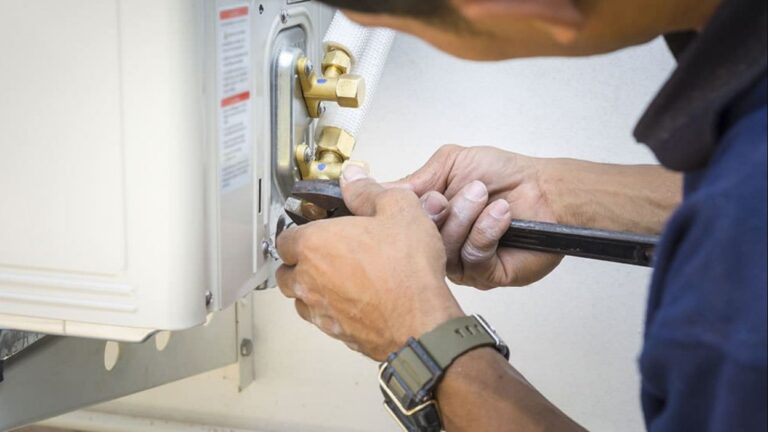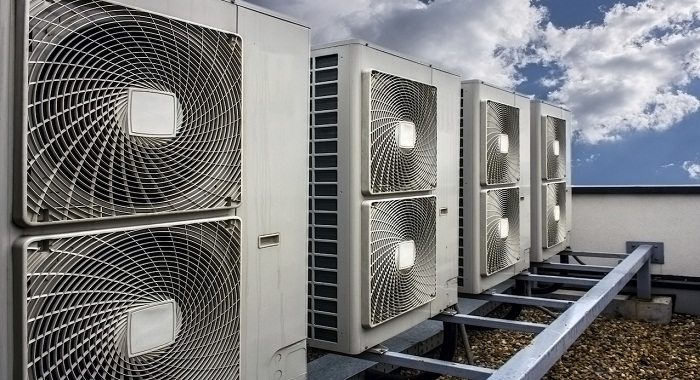The Best Smart Thermostats for Your HVAC System in 2025
As we step into 2025, homeowners are increasingly looking for ways to optimize their home’s climate control while reducing energy costs. One of the most effective ways to achieve this is by upgrading to a smart thermostat. These innovative devices have revolutionized the way we control our home’s temperature, offering advanced features such as air quality monitoring, occupancy detection, and AI-powered energy optimization.
With so many options available in the market, choosing the right thermostat for your HVAC system can be overwhelming. This comprehensive guide will help you navigate the complex world of smart thermostats and find the perfect match for your home.
Key Takeaways
- Discover the top-rated smart thermostats for your HVAC system in 2025
- Learn how smart thermostats can revolutionize your home’s climate control
- Understand the key features to look for when choosing a smart thermostat
- Find out how smart thermostats can help reduce energy costs
- Explore the compatibility of smart thermostats with different HVAC systems
Understanding Smart Thermostats and Their Benefits

Smart thermostats have transformed the way we manage our home’s temperature, offering a blend of comfort, convenience, and energy efficiency. Unlike traditional thermostats, smart thermostats learn your preferences and habits to automatically adjust temperatures for optimal comfort and efficiency.
How Smart Thermostats Revolutionize Home Climate Control
Smart thermostats revolutionize home climate control by providing advanced features such as remote access, scheduling, and geofencing. These features allow homeowners to adjust their heating and cooling systems remotely, ensuring that their home is always at a comfortable temperature when they arrive.
The ability of smart thermostats to learn and adapt to a household’s temperature preferences is a significant advancement. By doing so, they not only enhance comfort but also contribute to energy savings by minimizing unnecessary heating and cooling.
Energy Savings and Environmental Impact
The energy savings potential of smart thermostats is substantial. Studies have shown that these devices can lead to significant reductions in heating and cooling costs, thereby lowering overall energy consumption.
| Feature | Traditional Thermostats | Smart Thermostats |
|---|---|---|
| Learning Capabilities | No | Yes |
| Remote Access | No | Yes |
| Energy Usage Reporting | No | Yes |
By reducing energy consumption, smart thermostats also have a positive environmental impact. Lower energy usage translates to a reduced carbon footprint, contributing to a more sustainable future.
Key Features to Look for in a Smart Thermostat for HVAC
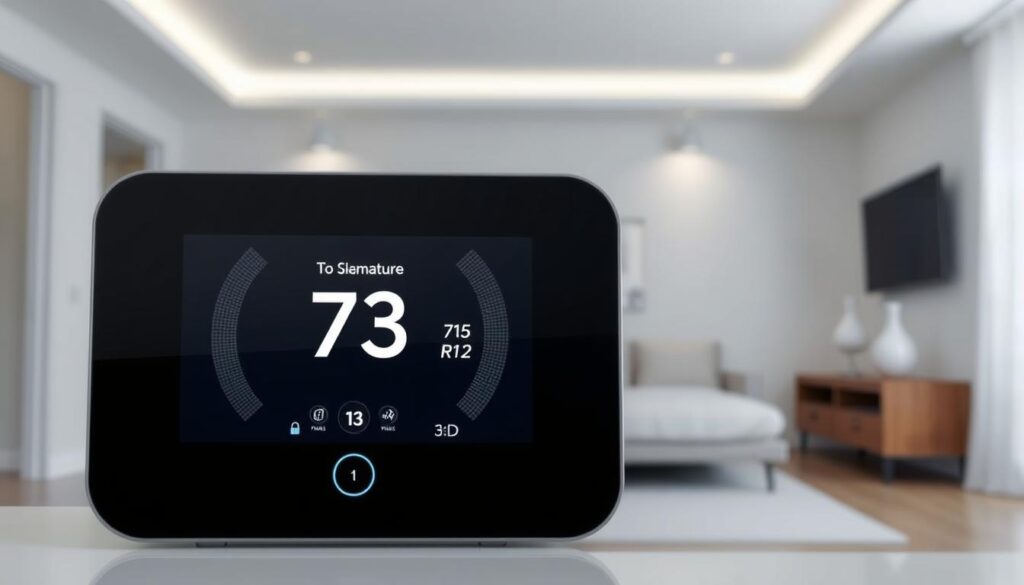
When selecting a smart thermostat for your HVAC system, it’s crucial to consider several key features that can significantly impact your home’s comfort and energy efficiency. A smart thermostat can offer a range of advanced features that not only enhance your home’s climate control but also provide significant energy savings.
Learning Capabilities and AI Integration
One of the most advanced features in modern smart thermostats is their ability to learn and adapt to your lifestyle. Learning capabilities and AI integration enable thermostats to create personalized comfort settings without the need for manual programming. For instance, the Nest Learning Thermostat can learn your schedule and preferences to automatically adjust the temperature, ensuring your home is always comfortable while optimizing energy usage.
Remote Sensors and Temperature Balancing
Many smart thermostats come with the option to use remote sensors that can be placed in various rooms around your home. These remote sensors help to balance temperatures throughout your home, eliminating hot and cold spots for more consistent comfort. By ensuring that every room is at a comfortable temperature, you can enhance your overall living experience.
Energy Usage Reporting and Optimization
Energy usage reporting is another critical feature that helps homeowners understand their consumption patterns and identify opportunities for optimization and savings. By providing detailed insights into your energy usage, smart thermostats empower you to make informed decisions about your energy consumption, potentially leading to significant savings on your utility bills.
Smart Home Integration Options
The ability to integrate with various smart home ecosystems is also a key consideration. Popular options include Amazon Alexa, Google Assistant, Apple HomeKit, and Samsung SmartThings. This integration allows for seamless control of your thermostat via voice commands or through a single, unified app, enhancing convenience and flexibility in managing your home’s climate.
HVAC System Compatibility Considerations
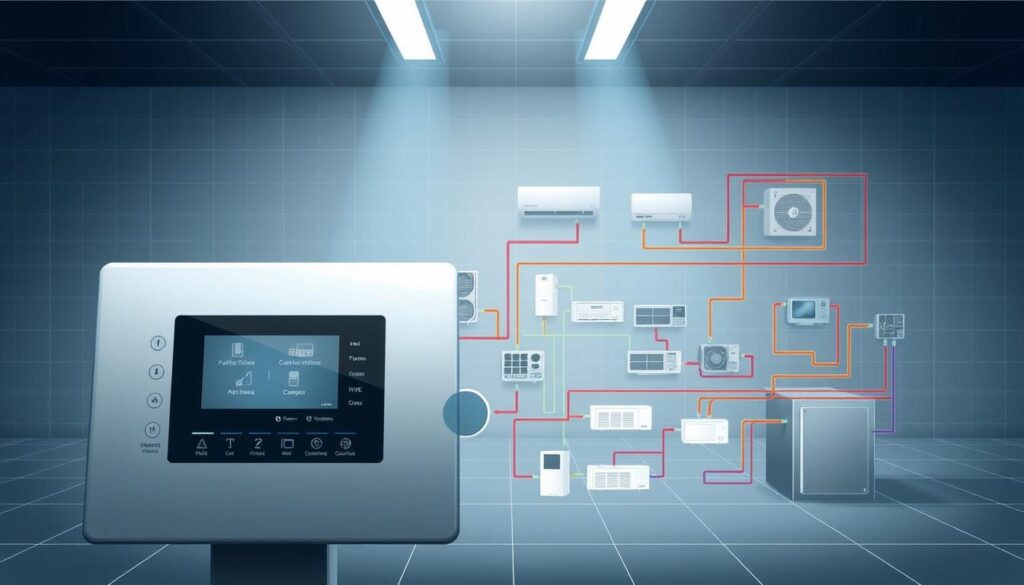
Ensuring your smart thermostat is compatible with your HVAC system is crucial for optimal performance and energy efficiency. Not all smart thermostats work seamlessly with every HVAC system, and compatibility issues can lead to subpar performance or even installation challenges.
Understanding your HVAC system’s configuration is the first step in selecting a compatible smart thermostat. This involves knowing whether you have a multi-stage or single-stage heating and cooling system.
Multi-Stage vs. Single-Stage System Support
Multi-stage HVAC systems offer more precise temperature control by operating at different capacities. Smart thermostats that support multi-stage systems can adjust their output accordingly, providing better comfort and potentially greater energy savings. In contrast, single-stage systems operate at a fixed capacity, and while they can still be controlled by smart thermostats, the benefits may be more limited compared to multi-stage systems.
When choosing a smart thermostat, it’s essential to select a model that supports your HVAC system’s configuration. For instance, if you have a multi-stage system, you’ll want a thermostat that can handle multiple stages to maximize efficiency and performance.
C-Wire Requirements and Workarounds
One common issue when installing smart thermostats is the requirement for a C-wire (common wire). The C-wire provides continuous power to the thermostat, which is necessary for many smart models. If your HVAC system doesn’t have a C-wire, there are often workarounds available, such as adapters or alternative wiring configurations.
It’s crucial to check if your chosen smart thermostat requires a C-wire and to understand the available options if your system lacks one. Some thermostats are designed to work without a C-wire, using batteries or other power-saving technologies instead.
Line Voltage vs. Low Voltage Systems
HVAC systems can be categorized into line voltage and low voltage systems. Line voltage systems, often used for electric baseboard heating, operate directly off the household electrical voltage. Low voltage systems, more common in traditional HVAC setups, use a transformer to step down the voltage.
Smart thermostats designed for line voltage systems are typically different from those for low voltage systems. Ensuring you have the correct type of thermostat for your system’s voltage requirements is vital for safe and effective operation.
In conclusion, checking the compatibility of your smart thermostat with your HVAC system before purchase is not just recommended; it’s essential for avoiding potential headaches during installation and ensuring your system operates at its best.
Best Thermostat for HVAC: Top Premium Option
In the realm of smart thermostats, the Ecobee Smart Thermostat Premium emerges as a leader, boasting advanced features that set it apart from the competition. This premium device is designed to provide homeowners with a comprehensive solution for managing their HVAC systems, ensuring optimal comfort and energy efficiency.
Ecobee Smart Thermostat Premium
Overview
The Ecobee Smart Thermostat Premium is our top pick for the best smart thermostat for HVAC systems. It comes with a remote SmartSensor that balances temperatures throughout your home, ensuring a consistently pleasant environment. The device also features a built-in smart speaker, compatible with both Alexa and Siri, making it a versatile addition to any smart home.
Pros
The Ecobee Smart Thermostat Premium offers several key advantages. Its exceptional temperature consistency is a significant benefit, ensuring that your home remains comfortable year-round. The device also supports multiple smart home platforms, including Amazon Alexa, Apple HomeKit, and Google Assistant, providing seamless integration with various smart devices. Furthermore, Ecobee’s commitment to privacy is noteworthy, with a privacy policy that is considered best-in-class.
Cons
While the Ecobee Smart Thermostat Premium is an outstanding device, it does come with a premium price tag. Potential buyers should also be aware of any limitations in compatibility with certain HVAC systems or smart home platforms. However, for most users, the benefits will outweigh these drawbacks.
Features
The Ecobee Smart Thermostat Premium is packed with innovative features. It includes air quality monitoring, allowing homeowners to stay informed about the indoor air quality. The device can also function as a home security device and a smart speaker, adding to its versatility. With support for five different smart home platforms, users can enjoy seamless integration with their existing smart home ecosystems.
Best AI-Powered Smart Thermostat
With its cutting-edge AI and sleek design, the Google Nest Learning Thermostat (4th Gen) is redefining the smart thermostat landscape.
Google Nest Learning Thermostat (4th Gen)
Overview
The Google Nest Learning Thermostat (4th Gen) is designed to make your life easier by automatically adjusting the temperature in your home. Its built-in AI learns your schedule and preferences to optimize comfort and energy savings.
This thermostat features a sleek and modern design that fits well with any home decor. The high-resolution display provides clear information at a glance.
Pros
The Nest Learning Thermostat (4th Gen) offers several advantages, including its ability to learn and adapt to your temperature preferences. It also provides detailed energy usage reports, helping you understand and manage your energy consumption.
Key Benefits: Enhanced AI for better temperature control, sleek design, and compatibility with Nest Temperature Sensors.
Cons
While the Nest Learning Thermostat (4th Gen) is a powerful device, it lacks motion detection in its remote sensors, which might limit its ability to accurately sense occupancy in certain areas.
Some users may also experience compatibility issues with certain HVAC systems or smart home platforms.
Features
The Google Nest Learning Thermostat (4th Gen) comes with a range of innovative features, including Farsight technology, which displays important information from across the room.
Notable Features: Energy history reporting, compatibility with Google Assistant, and a user-friendly app for remote control.
The thermostat also supports multiple temperature sensors, allowing for more precise temperature control throughout your home.
Best Budget-Friendly Smart Thermostats
You can now enjoy the benefits of a smart thermostat without the hefty price tag. In this section, we’ll explore two excellent budget-friendly options that offer impressive functionality without compromising on key features.
Nest Thermostat
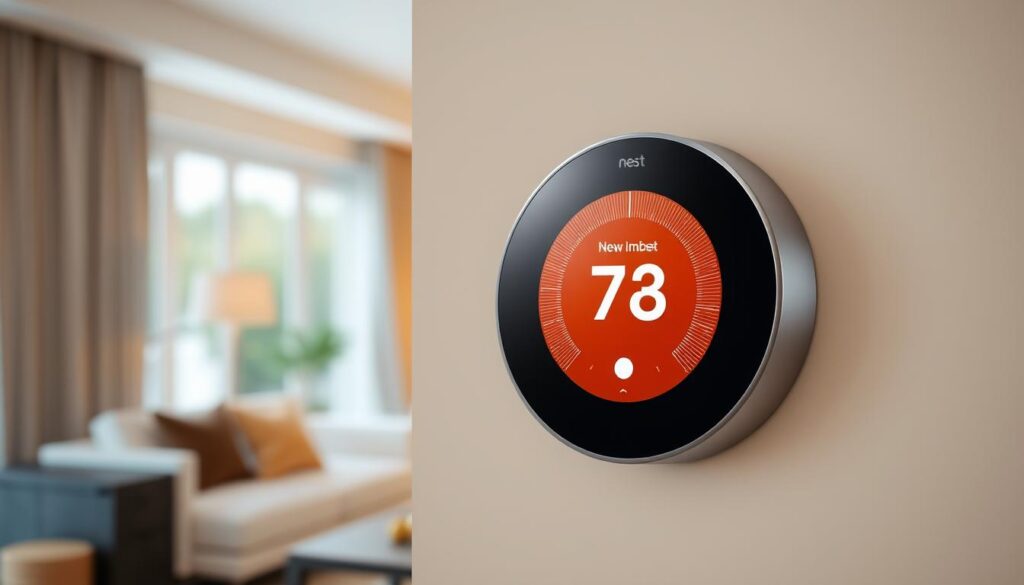
Overview
The Nest Thermostat is a simplified version of the Learning model, offering an attractive design and intuitive controls at a more accessible price point. It’s designed to work seamlessly with the Google Home ecosystem, making it an excellent choice for those already invested in Google’s smart home products.
With its sleek design, the Nest Thermostat fits well with most home decor styles. It’s easy to install and set up, with a user-friendly interface that makes adjusting the temperature a breeze.
Pros
The Nest Thermostat has several strengths, including its attractive design, intuitive controls, and seamless integration with Google Home. It’s also energy-efficient and can help you save on your heating and cooling bills.
Cons
Some users may find that the Nest Thermostat lacks some of the advanced features available in more premium models. However, for its price, it offers excellent value.
Features
The Nest Thermostat comes with a range of features, including temperature control, energy usage reporting, and smart alerts. It can also be controlled remotely using the Google Home app.
Amazon Smart Thermostat
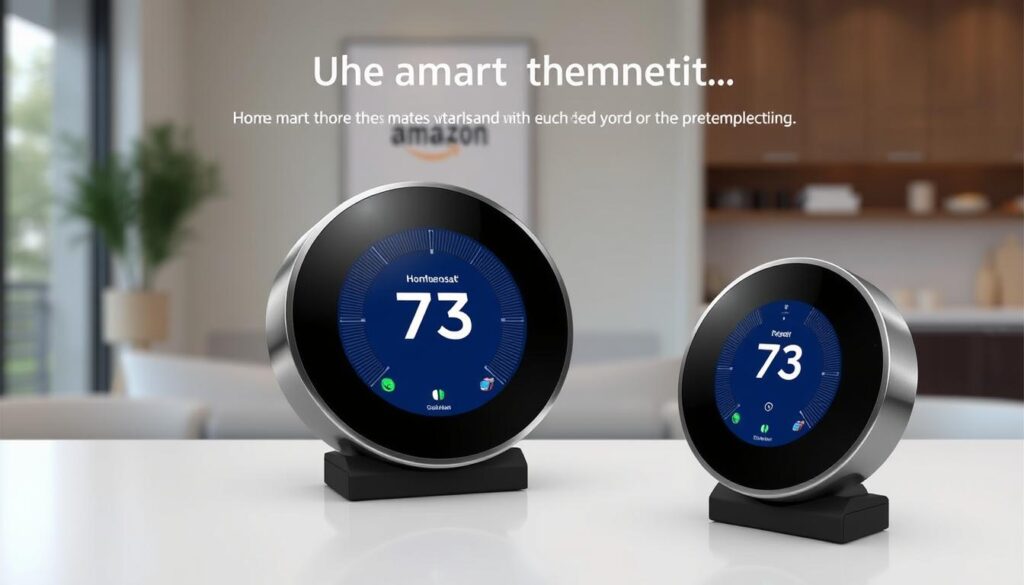
Overview
The Amazon Smart Thermostat is a basic yet functional device that offers excellent value for its price. It’s designed to work seamlessly with Alexa, allowing for voice control and integration with other smart devices.
One of the standout features of the Amazon Smart Thermostat is its ease of installation. The device is simple to set up, and the accompanying app provides clear instructions to guide you through the process.
Pros
The Amazon Smart Thermostat impresses with its remarkable ease of installation, seamless Alexa integration, and excellent value. It’s a great option for those looking for a budget-friendly smart thermostat that still offers key features.
Cons
Some users may find the Amazon Smart Thermostat’s basic functionality and rudimentary AI to be limiting. However, for its price, it’s a great option.
Features
The Amazon Smart Thermostat offers a range of features, including temperature control, energy usage reporting, and Alexa Hunches, which allows the device to learn your patterns and suggest customized settings.
Best Smart Thermostats for Remote Room Monitoring
The Honeywell Home T9 Smart Thermostat stands out for its advanced remote room monitoring capabilities.
Honeywell Home T9 Smart Thermostat
Overview
The Honeywell Home T9 Smart Thermostat is a high-end solution designed to provide comprehensive temperature management across multiple rooms. It comes with a remote room sensor in the box, allowing users to monitor two parts of their house simultaneously.
This thermostat is not only feature-rich but also easy to install, thanks to its intuitive design and big, friendly touch screen.
Pros
The Honeywell Home T9 offers several advantages, including its ability to maintain uniform temperatures throughout the home. Users can add up to 20 remote room sensors to detect both temperature and occupancy.
Key benefits include targeted climate control that prioritizes occupied spaces, potentially reducing heating costs.
Cons
While the Honeywell Home T9 is a robust solution, it may have some limitations, such as compatibility issues with certain HVAC systems or features that might be lacking compared to other premium options.
Users should review these aspects to ensure it meets their specific needs.
Features
The Honeywell Home T9 Smart Thermostat boasts an array of features, including smart home integration with Google Assistant and Amazon Alexa. Its remote room sensors play a crucial role in detecting temperature and occupancy.
This allows for more precise control over the home’s climate, enhancing comfort and potentially reducing energy bills.
Best Touch Screen Smart Thermostats
For those who find traditional dials and simple temperature displays outdated, the Sensi Touch 2 Smart Thermostat ST76 offers a modern alternative with its expansive 4.3-inch color touch screen.
The Sensi Touch 2 Smart Thermostat ST76 is a significant departure from traditional thermostat designs, offering a sleek and modern interface that’s entirely based on a large touch screen. This design choice not only enhances the aesthetic appeal of the device but also simplifies user interaction.
Sensi Touch 2 Smart Thermostat ST76
The Sensi Touch 2 is designed with the user in mind, featuring an intuitive interface that’s easy to navigate. Its large display ensures that all necessary information is readily available at a glance.
Overview
The Sensi Touch 2 Smart Thermostat ST76 is equipped with a 4.3-inch color touch screen, making it one of the largest and most intuitive displays in its class. This thermostat is designed to work seamlessly with various smart home systems, including Amazon Alexa and Google Assistant.
Pros
One of the standout features of the Sensi Touch 2 is its compatibility with up to 15 room sensors, allowing for precise temperature monitoring and balancing across different zones in the home. The thermostat’s touch screen interface is also highly responsive, making it easy to adjust settings and access advanced features.
Cons
While the Sensi Touch 2 offers many advantages, there are some potential drawbacks to consider. For example, the touch screen display may be prone to fingerprints, and some users might find the interface overwhelming at first due to the wealth of information and options available.
Features
The Sensi Touch 2 Smart Thermostat ST76 boasts an impressive array of features, including remote temperature monitoring, smart alerts, and energy usage reporting. Its compatibility with popular smart home platforms ensures that users can control their thermostat using voice commands or through a dedicated app.
Best Smart Thermostats for HomeKit Users
In the realm of smart thermostats, the Sensi ST55 distinguishes itself by offering HomeKit compatibility at a relatively affordable price, making it a compelling option for Apple devotees.
Sensi Smart Thermostat ST55
Overview
The Sensi Smart Thermostat ST55 is a rare gem for Apple HomeKit users, offering a blend of traditional design and modern smart functionality. Its flat, rectangular face and monochrome LCD display may not scream “smart thermostat,” but it packs a punch with its compatibility with HomeKit, Amazon Alexa, and Google Assistant.
It supports geofencing, allowing for automated temperature adjustments based on your location. This makes it an excellent choice for those who want to control their home’s temperature using Siri or other voice assistants.
Pros
Affordable HomeKit Compatibility: The ST55 is one of the more budget-friendly options for those invested in the Apple ecosystem.
Multi-Voice Assistant Support: It works not only with Siri but also with Amazon Alexa and Google Assistant, offering flexibility in voice control.
Geofencing: The thermostat can adjust temperatures based on your location, enhancing energy efficiency and comfort.
Cons
Basic Display: The monochrome LCD display, while functional, lacks the sophistication of some premium models.
Limited Advanced Features: Compared to high-end smart thermostats, the ST55 may seem basic in terms of features and design.
Features
The Sensi ST55 boasts a range of features that make it an attractive option for HomeKit users. These include:
- Compatibility with Apple HomeKit for seamless integration with other Apple devices
- Support for Amazon Alexa and Google Assistant for multi-voice control
- Geofencing capabilities for automated temperature adjustments
- A user-friendly app for remote control and scheduling
With its unique blend of compatibility, functionality, and affordability, the Sensi Smart Thermostat ST55 is a strong contender for those looking to integrate a smart thermostat into their Apple HomeKit setup.
Best Smart Thermostats for Electric Heating Systems
The Mysa Smart Thermostat (v2) is designed specifically for electric baseboard heating and other high-voltage systems.
The Mysa Smart Thermostat (v2) is a specialized device that brings smart control to electric baseboard heating, fan-forced convector, and other high-voltage heating systems. Standard smart thermostats are not compatible with line-voltage electric heating systems, making Mysa a valuable solution for homeowners with these systems.
Mysa Smart Thermostat (v2)
Overview
The Mysa Smart Thermostat (v2) offers advanced features such as scheduling, geofencing, and an “Eco” mode that subtly drops the temperature to save energy without affecting comfort. It is designed to work with high-voltage resistance heating systems, providing a smart solution for homes that use electric baseboard heating.
Pros
The Mysa Smart Thermostat (v2) can help homeowners save up to 26% on their annual heating bill. It features a sleek design, smartphone app control, and compatibility with major smart home platforms. For multi-room setups, the Mysa Lite is a more affordable option with basic controls and fewer features.
Cons
One of the limitations of the Mysa Smart Thermostat (v2) is that it is not designed to control cooling systems. Additionally, for homes that require multiple thermostats, the cost can add up, although the Mysa Lite offers a more budget-friendly alternative.
Features
The Mysa Smart Thermostat (v2) includes features such as energy usage reporting, scheduling, and geofencing. It is compatible with various smart home systems, allowing for seamless integration into existing smart home setups.
Installation and Setup Guide for Smart Thermostats
With years of experience testing thermostats, we’ve developed a comprehensive guide to help you install and set up your smart thermostat. At GearLab, we’ve been testing thermostats for nearly a decade, evaluating top products across multiple metrics, including user experience, installation, scheduling capabilities, smart features, energy efficiency, and environmental consciousness.
DIY Installation Tips and Best Practices
To ensure a smooth DIY installation, start by turning off the power to your HVAC system at the breaker box. This is a crucial safety precaution to avoid any electrical shocks or injuries. Next, identify the wiring configuration of your old thermostat and match it to the corresponding wires on your new smart thermostat. Most smart thermostats come with a wiring diagram or online resources to help with this process. Always refer to your thermostat’s manual for specific wiring instructions, as configurations can vary.
When mounting the new thermostat, choose a location that is easily accessible and provides an accurate reading of the room temperature. Avoid placing it near heating or cooling vents, windows, or doors that could affect its performance. If you’re unsure about any part of the installation, consider consulting online resources or contacting a professional.
Professional Installation: When to Consider It
While many homeowners can successfully install a smart thermostat themselves, there are situations where professional installation is recommended. If your home has a complex HVAC system, is missing a C-wire, or you’re not comfortable working with electrical components, it’s best to hire a professional. Additionally, if you’re unsure about any aspect of the installation, a professional can ensure that the job is done correctly and safely.
Initial Setup and Configuration
After physically installing your smart thermostat, you’ll need to complete the initial setup process. This typically involves connecting the thermostat to your Wi-Fi network, creating an account with the manufacturer’s app, and configuring basic settings such as temperature preferences and scheduling. Be sure to follow the manufacturer’s instructions for the app and thermostat setup to ensure you can take full advantage of your smart thermostat’s features.
By following these guidelines, you can enjoy the benefits of your new smart thermostat, including enhanced energy efficiency and increased comfort in your home.
Maximizing Energy Savings with Smart Thermostats
To get the most out of your smart thermostat, it’s essential to understand how to maximize its energy-saving capabilities. By optimizing your thermostat’s settings and utilizing its advanced features, you can significantly reduce your energy consumption and lower your utility bills.
Optimal Temperature Settings and Schedules
One of the most effective ways to save energy is by setting optimal temperature settings and schedules. For instance, you can set your thermostat to decrease the temperature when you’re not home or when you’re sleeping. Even small adjustments, such as lowering the temperature by 1-2 degrees, can lead to significant energy savings.
- Set your thermostat to a lower temperature in winter and a higher temperature in summer when you’re not home.
- Create a schedule that adjusts the temperature based on your daily routine.
Utilizing Geofencing and Occupancy Detection
Geofencing and occupancy detection are powerful features that allow your smart thermostat to automatically adjust the temperature based on your location and whether anyone is home. Enabling geofencing lets your thermostat know when you’re approaching home or leaving, so it can adjust the temperature accordingly.
Monitoring and Analyzing Energy Usage Reports
Many smart thermostats provide detailed energy usage reports that help you understand your consumption patterns. By analyzing these reports, you can identify areas for improvement and make adjustments to optimize your energy savings.
Making the Right Choice for Your Home
Now that you’ve explored the various smart thermostat options, it’s time to make an informed decision for your home. Choosing the right smart thermostat can significantly impact your comfort, energy bills, and the overall efficiency of your HVAC system.
To make the best choice, consider your HVAC system type, existing smart home ecosystem, budget constraints, and feature priorities. For instance, if you have a large home with temperature variations, you might prefer a smart thermostat with remote sensors like the Honeywell Home T9. For simpler heating and cooling systems, a more straightforward option like the Nest Thermostat could be ideal.
When evaluating smart thermostats, also consider features such as geofencing, energy usage reporting, and compatibility with your HVAC system. If you’re invested in a particular smart home platform, ensure the thermostat you choose integrates seamlessly. For those looking for the best smart thermostats, models like the Ecobee Smart Thermostat Premium and Google Nest Learning Thermostat (4th Gen) are top contenders.
To learn more about optimizing your HVAC system, you can check out resources like what is the top-rated residential HVAC system in. By choosing the right thermostat, you’ll not only enhance your home’s comfort but also contribute to broader energy conservation efforts.
Ultimately, the right smart thermostat will balance price, features, and performance, ensuring a comfortable home environment while minimizing energy waste.


